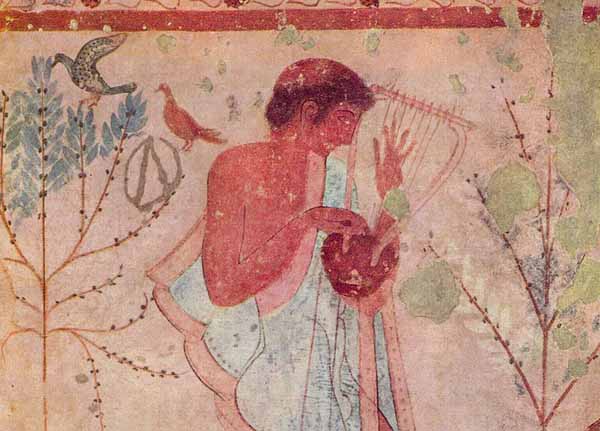All that remains of this mysterious civilization are funerary art and inscriptions found in their elaborate underground tombs.
Nothing of much certainty is known about the origins of the Etruscan culture, which flourished in central Italy during the same era as classic Greek civilization and many generations before the rise of the Roman Empire. The Etruscans are the ancient people of Etruria, an area roughly equivalent to modern Tuscany, that flourished between about 800 and 300 B.C. Nothing remains, for instance, of Etruscan palaces, public buildings, or early temples, all built of wood and brick. They left no body of literature behind; today we have only votive or funerary inscriptions. So the Etruscan culture remains mysterious.
All that remains of this remarkable civilization, in fact, is what has been found in their underground tombs. Like the Egyptians, the Etruscans were very much interested in the hereafter and in ensuring that their dead were comfortable in the afterlife. The tombs were typically carved from living rock with walls, windows, and doorframes, all decorated with household objects the dead might need in the afterlife. Much of the art left to us is in the form of frescoes or clay funerary sculpture, all found in these tombs. Frescoes adorned the walls of the tombs. Coffin lids were meticulously embellished with relief sculptures, often of the deceased husband and wife whose remains are contained within.
Etruscan art is very much influenced by the Greeks, who were already an established and thriving civilization. For example, a coffin has on its lid a couple, reclining as though at their own funerary banquet. The Greek influence is obvious in the Archaic smile and the stylized features.
However, Etruscan art has unique character and vitality. Not as tied to an ideal of perfection or beauty as were the Greeks, Etruscan artists often show their subjects in all their imperfections, perhaps slightly overweight or with homely features. By way of illustration, a later example of sarcophagus art realistically depicts a rather homely middle-aged couple.
Etruscan fresco paintings decorated tomb walls with depictions of everyday life or of the games, dancing, music, and feasting that accompanied their funerals. There is an unmistakable vitality in their paintings, showing characteristic Etruscan exuberance and joy of life. Their scenes record natural, realistic, and playful settings and always recount an event or a story. They love using color in their work. The drawing skill is strong, the figures are outlined in black, and though the lack of modeling makes the scenes or figures appear flat, they burst with brightness and energy. Male and female figures are distinguished from one another by different skin color as in the contemporary Egyptian and Minoan paintings. Again the evidence of Greek influence is strong, as in these dancers prancing next to a Greek-style amphora.
An artistic, cultured, socially advanced, economically prosperous, and pleasure-loving people, the Etruscans flourished for several hundred years until they were taken over by Rome about 300 B.C. Their civilization was absorbed by the Romans and their identity obliterated. Scholars believe their influence on modern western civilization is imortant but overshadowed by that of the Greeks and Romans. Whatever their origin, the Etruscans are an enigma of history.








